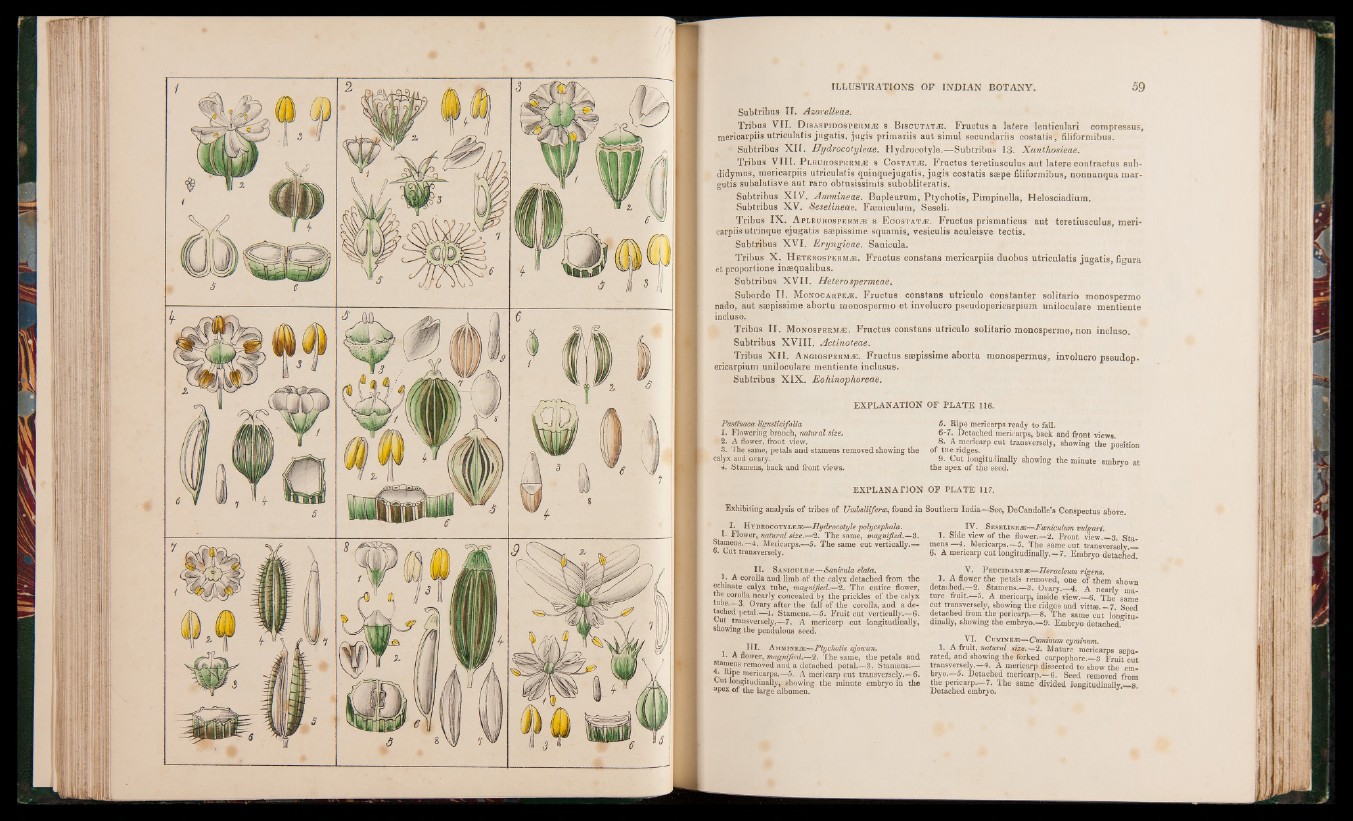
ï
Subtribus Iî. Azorelleae.
Tribus VII. D jsaspidospermæ s B iscutatæ. Fructus a latere lenticulari compressus,
mericarpiis utriculatis jugatis, jugis primariis aut simul secundariis costatis, filiformibus.
Subtribus XII. Hydrocotyleae. Hydrocotyle.—Subtribus 13. Xanthosieae.
Tribus VIII. P leürospermæ s C ostatæ. Fructus teretiusculus aut latere contractus sub-
didymus, mericarpiis utriculatis quinquejugatis, jugis costatis sæpe filiformibus, nonnunqua mar-
gutis subalatisve aut raro obtusissimis subobliteratis.
Subtribus XIV. Ammineae. Bupleurum, Ptychotis, Pimpinella, Helosciadium.
Subtribus XV. Seselineae. Fæniculum, Seseli.
Tribus IX. A plburospbrmæ s E costatæ. Fructus prismaticus aut teretiusculus, mericarpiis
utrinque ejugatis sæpissime squamis, vesiculis aculeisve tectis.
Subtribus XVI. Eryngieae. Sanioula.
Tribus X. H eterospermæ. Fructus constans mericarpiis duobus utriculatis jugatis, figura
et proportione inæqualibus.
Subtribus XVII. Heterospermeae.
Subordo II. M onocarpeæ. Fructus constans utriculo constanter solitario monospermo
nado, aut sæpissime abortu monospermo et involucro pseudopericarpium uniloculare mentiente
incluso.
Tribus II. Monospermæ. Fructus constans utriculo solitario monospermo, non incluso.
Subtribus XVIII. Actinoteae.
Tribus XII. A ngiospermæ. Fructus sæpissime abortu monospermus, involucro pseudop.
ericarpium uniloculare mentiente inclusus.
Subtribus XIX. Eohinophoreae.
EXPLANATION OF PLATE 116.
Pastinaca ligusticifolia
1. Flowering branch, natural size.
2. A flower, front view.
3. The same, petals and stamens removed showing the
calyx and ovary.
4. Stamens, back and front views.
5. Ripe mericarps ready to fall.
6-7. Detached mericarps, back and front views.
8. A mericarp cut transversely, showing the position
o f tbe ridges. r
9. Cut longitudinally showing the minute embryo at
the apex o f the seed. J
EXPLANATION OF PLATE 117.
Exhibiting analysis o f tribes o f Umbelliferce, found in Southern India—See, DeCandolle’s Conspectus above.
I. H ydrocotyle^e—Hydrocotyle polycephala.
1. Flower, natural size.—2. The same, magnified.—3.
Stamens.—4. Mericarps.—5. The same cut vertically.—
6. Cut transversely.
II. Sanicule/e—Sanicula elata.
1. A corolla and limb of the calyx detached from the
echinate calyx tube, magnified.—2. The entire flower,
the corolla nearly concealed by the prickles o f the calyx
tube.— 3. Ovary after the fall of the corolla, and a detached
petal.—4. Stamens.—5. Fruit cut vertically.—6.
Cut transversely.—7. A mericarp cut longitudinally,
showing the pendulous seed.
III. Ammineje—Ptychotis ajoivan.
L A flower, magnified.—2. The same, the petals and
stamens removed and a detached petal.—3. Stamens.—
C Ripe mericarps.—5. A mericarp cut transversely.—6.
Cut longitudinally, showing the minute embryo in the
apex of the large albumen.
IV. S ese l in e^e—Fceniculum vvlgari,
1. Side view of the flower.—2. Front view.—3. Stamens—
4. Mericarps.—5. The same cut transversely.__
6. A mericarp cut longitudinally.—7. Embryo detached.
V. P euc id a n e je—Heraeleum rigens.
1. A flower the petals removed, one o f them shown
detached.—2. Stamens.—3. Ovary.—4. A nearly mature
fruit.—5. A mericarp, inside view.—6. The same
cut transversely, showing the ridges and vitt®.—7. Seed
detached from the pericarp.—8. The same cut longitudinally,
showing the embryo.—9. Embryo detached.
VI. CoMiNEiE—Cuminum cyminum.
1« A fruit, natural size.— 2. Mature mericarps separated,
and showing the forked carpophore.—3 Fruit cut
transversely.—4. A mericarp dissected to show the embryo.—
5. Detached mericarp.— 6. Seed removed from
the pericarp. 7. The same divided longitudinally.—8.
Detached embryo.